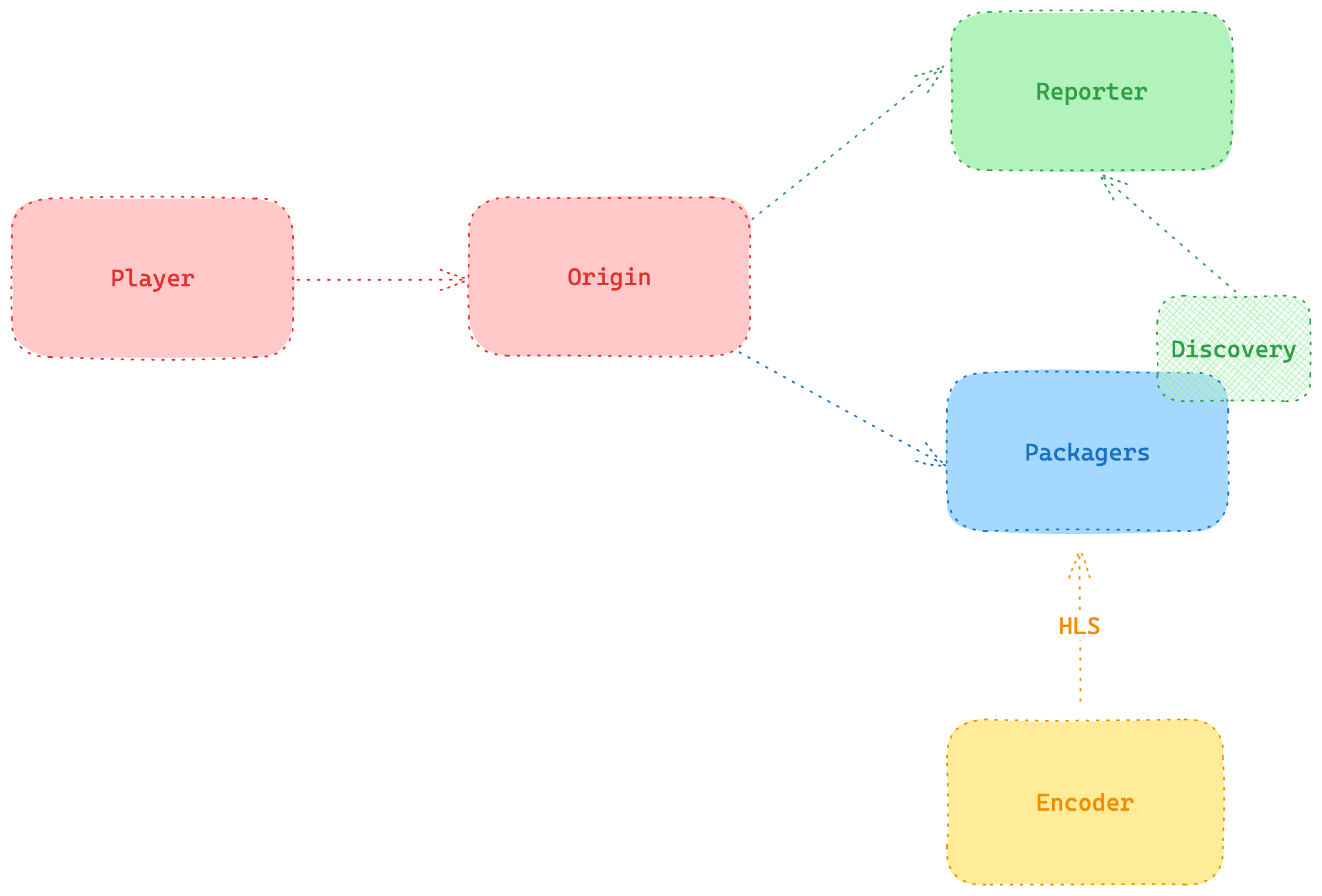The true purpose of this project is to set up a zero downtime strategy for a Live Stream event.
We seek to emulate a live streaming platform architecture, as close to a real one as possible, like in the picture below - all using Golang (and a bit of FFMPEG).
First, For this, we use FFMPEG + Golang to produce an HLS playlist and publish it in two separate HTTP servers. This is done by running three different containers:
- worker - Builds and runs the FFMPEG command to generate a live stream output, whose manifest and segments are stored in the folder given by the
OUTPUT_STREAM_PATHenv variable. The input MP4 video used by theworkerservice to generate the FFMPEG is stored in the folder given by the env variableINPUT_STREAM_PATH. - server1 and server2 - Each execute a different HTTP server with equal configurations but different ports (
SERVER_ONE_PORTandSERVER_TWO_PORT).
These services can be run by calling, in different terminal tabs, the commands below - these will use the Go executable go run to start the services, but the option to use Docker instead is also available in the Makefile.
make run-local-worker
make run-local-server1
make run-local-server2The output live stream will be an HLS playlist, which can be played in Safari or VLC using the following URLs:
localhost:8080/live01/playlist.m3u8 ## using server1
localhost:9090/live01/playlist.m3u8 ## using server2This way, the worker service acts as our mock encoder, whose HLS content will be published by our mock packagers, represented by server1 and server2.
The next logical step is building a discovery and reporter service, which will be read by our origin to know which signals are active in which packagers. This information will be important for our origin to know from which packager to fetch the content from, and will be especially crucial for when we implement the zero downtime policy.
Thus, we now have two other containers, which also run separately:
- discovery - Reads the contents from the disk to verify which signals are being ingested (AKA generated by worker) and calls a healthcheck on all packagers (AKA server1 and server2) to verify which are active. Then, it assembles all the gathered information and sends it to the reporter service using a HTTP POST. OBS: Execution will fail if the reporter service is not active.
2024-04-05 11:23:05 INF Registered signal 'live01' as ingest source- reporter - Implements an API that receives the ingest information from the discovery service and stores it in a local cache. Then, it uses the information from the cache to expose a JSON with the active ingest information on the route
http://localhost:2000/ingests:
[
{
"signal": "live01",
"packagers": [
"http://localhost:8080",
"http://localhost:9090"
],
"last_reported": "Fri, 05 Apr 2024 11:23:45 -03"
}
]
⚠️ Since both servers (server1 and server2) and the reporter all implement different HTTP servers which will all be run on the same hosthttp://localhost, to differentiate them, each service is executed on a different port::8080for server1,:9090for server2 and:2000for reporter. These values are controlled by the environment variablesSERVER_ONE_PORT,SERVER_TWO_PORTandREPORTER_PORT, respectively.
To run these services, as was done in the previous section, we use the commands available in the Makefile (also running them in separate terminal tabs):
make run-local-reporter
make run-local-discoveryThe origin service connects all the services detailed before to the final client, such as a player or a playback/delivery API. The client sends a request for a signal and the origin service checks with the reporter service which packager is being used to publish it, and then, returns the requested content to the client.
To run this service, use the Makefile command below:
make run-local-originThe origin runs on the http://localhost:8001 endpoint, and it serves two routes.
The first /signals is used to return a list with the names of all active signals:
curl -v http://localhost:8001/signals[
"live01"
]The second, /live/<name>, receives the signal's name as a query parameter, and returns an active ingest source (i.e. packager) for this signal:
curl -v http://localhost:8001/live/live01{
"signal": "live01",
"server": "http://localhost:8080/live01/playlist.m3u8"
}The proxy service redirects the player request to the active streaming server. If an active stream fails (i.e. the active packager suddenly becomes unavailable), the proxy will automatically redirect the stream to the next available packager. This switch works with little to no impact to the playback, avoiding video freezing, buffering or a need to reload the stream - and, thus, providing the client watching the live stream with practically zero down time.
⚠️ Of course, this server only runs correctly if all the services before are already running.
make run-local-proxycurl -v localhost:8002/live01/playlist.m3u8
To test the entire workflow and play the live stream using a playback client, execute all the services described previously in the following order:
- Worker
- Server 1
- Server 2
- Reporter
- Discovery
- Origin
- Proxy
Then, open the Safari Browser or VLC Player and play the signal URL http://localhost:8002/live01/playlist.m3u8.
